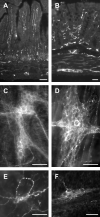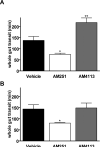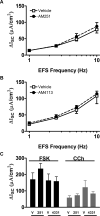Differential effects of CB(1) neutral antagonists and inverse agonists on gastrointestinal motility in mice
- PMID: 20180825
- PMCID: PMC2943391
- DOI: 10.1111/j.1365-2982.2010.01478.x
Differential effects of CB(1) neutral antagonists and inverse agonists on gastrointestinal motility in mice
Abstract
Background: Cannabinoid type 1 (CB(1)) receptors are involved in the regulation of gastrointestinal (GI) motility and secretion. Our aim was to characterize the roles of the CB(1) receptor on GI motility and secretion in vitro and in vivo by using different classes of CB(1) receptor antagonists.
Methods: Immunohistochemistry was used to examine the localization of CB(1) receptor in the mouse ileum and colon. Organ bath experiments on mouse ileum and in vivo motility testing comprising upper GI transit, colonic expulsion, and whole gut transit were performed to characterize the effects of the inverse agonist/antagonist AM251 and the neutral antagonist AM4113. As a marker of secretory function we measured short circuit current in vitro using Ussing chambers and stool fluid content in vivo in mouse colon. We also assessed colonic epithelial permeability in vitro using FITC-labeled inulin.
Key results: In vivo, the inverse agonist AM251 increased upper GI transit and whole gut transit, but it had no effect on colonic expulsion. By contrast, the neutral antagonist AM4113 increased upper GI transit, but unexpectedly reduced both colonic expulsion and whole gut transit at high, but not lower doses.
Conclusions & inferences: Cannabinoid type 1 receptors regulate small intestinal and colonic motility, but not GI secretion under physiological conditions. Cannabinoid type 1 inverse agonists and CB(1) neutral antagonists have different effects on intestinal motility. The ability of the neutral antagonist not to affect whole gut transit may be important for the future development of CB(1) receptor antagonists as therapeutic agents.
Figures






Similar articles
-
A role for O-1602 and G protein-coupled receptor GPR55 in the control of colonic motility in mice.Neuropharmacology. 2013 Aug;71(100):255-63. doi: 10.1016/j.neuropharm.2013.03.029. Epub 2013 Apr 18. Neuropharmacology. 2013. PMID: 23603203 Free PMC article.
-
Naphthalen-1-yl-(4-pentyloxynaphthalen-1-yl)methanone (SAB378), a peripherally restricted cannabinoid CB1/CB2 receptor agonist, inhibits gastrointestinal motility but has no effect on experimental colitis in mice.J Pharmacol Exp Ther. 2010 Sep 1;334(3):973-80. doi: 10.1124/jpet.110.169946. Epub 2010 Jun 22. J Pharmacol Exp Ther. 2010. PMID: 20571060
-
Central administrations of hemopressin and related peptides inhibit gastrointestinal motility in mice.Neurogastroenterol Motil. 2016 Jun;28(6):891-9. doi: 10.1111/nmo.12789. Epub 2016 Mar 14. Neurogastroenterol Motil. 2016. PMID: 26991932
-
Prejunctional and peripheral effects of the cannabinoid CB(1) receptor inverse agonist rimonabant (SR 141716).Naunyn Schmiedebergs Arch Pharmacol. 2008 Oct;378(4):345-69. doi: 10.1007/s00210-008-0327-2. Epub 2008 Jul 25. Naunyn Schmiedebergs Arch Pharmacol. 2008. PMID: 18654765 Review.
-
Central versus peripheral antagonism of cannabinoid CB1 receptor in obesity: effects of LH-21, a peripherally acting neutral cannabinoid receptor antagonist, in Zucker rats.J Neuroendocrinol. 2008 May;20 Suppl 1:116-23. doi: 10.1111/j.1365-2826.2008.01693.x. J Neuroendocrinol. 2008. PMID: 18426510 Review.
Cited by
-
Inhibitory effect of cannabichromene, a major non-psychotropic cannabinoid extracted from Cannabis sativa, on inflammation-induced hypermotility in mice.Br J Pharmacol. 2012 Jun;166(4):1444-60. doi: 10.1111/j.1476-5381.2012.01879.x. Br J Pharmacol. 2012. PMID: 22300105 Free PMC article.
-
Inhibiting endocannabinoid biosynthesis: a novel approach to the treatment of constipation.Br J Pharmacol. 2015 Jun;172(12):3099-111. doi: 10.1111/bph.13114. Epub 2015 Apr 23. Br J Pharmacol. 2015. PMID: 25684407 Free PMC article.
-
Multiple endocannabinoid-mediated mechanisms in the regulation of energy homeostasis in brain and peripheral tissues.Cell Mol Life Sci. 2019 Apr;76(7):1341-1363. doi: 10.1007/s00018-018-2994-6. Epub 2019 Jan 1. Cell Mol Life Sci. 2019. PMID: 30599065 Free PMC article. Review.
-
Inhibiting Fatty Acid Amide Hydrolase Ameliorates Enteropathy in Diabetic Mice: A Cannabinoid 1 Receptor Mediated Mechanism.Vet Sci. 2022 Jul 16;9(7):364. doi: 10.3390/vetsci9070364. Vet Sci. 2022. PMID: 35878381 Free PMC article.
-
Structure-Affinity Relationships and Structure-Kinetic Relationships of 1,2-Diarylimidazol-4-carboxamide Derivatives as Human Cannabinoid 1 Receptor Antagonists.J Med Chem. 2017 Dec 14;60(23):9545-9564. doi: 10.1021/acs.jmedchem.7b00861. Epub 2017 Nov 21. J Med Chem. 2017. PMID: 29111736 Free PMC article.
References
-
- Massa F, Storr M, Lutz B. The endocannabinoid system in the physiology and pathophysiology of the gastrointestinal tract. J Mol Med. 2005;83:944–954. - PubMed
-
- Izzo AA, Camilleri M. Emerging role of cannabinoids in gastrointestinal and liver diseases: basic and clinical aspects. Gut. 2008;57:1140–1155. - PubMed
-
- Izzo AA, Mascolo N, Capasso F. The gastrointestinal pharmacology of cannabinoids. Curr Opin Pharmacol. 2001;1:597–603. - PubMed
-
- Coutts AA, Izzo AA. The gastrointestinal pharmacology of cannabinoids: an update. Current Opinion in Pharmacology. 2004;4:572–579. - PubMed
-
- Li YY, Li YN, Ni JB, Chen CJ, Lv S, Wu RH, Yuece B, Storr M. Involvement of cannabinoid-1 and cannabinoid-2 receptors in septic ileus. Neurogastroenterol Motil. 2009 in press. - PubMed
Publication types
MeSH terms
Substances
Grants and funding
- CAPMC/ CIHR/Canada
- DA023142/DA/NIDA NIH HHS/United States
- R01 DA007215/DA/NIDA NIH HHS/United States
- R01 DA011322/DA/NIDA NIH HHS/United States
- DA7215/DA/NIDA NIH HHS/United States
- R37 DA003801/DA/NIDA NIH HHS/United States
- DA3801/DA/NIDA NIH HHS/United States
- R37 DA023142/DA/NIDA NIH HHS/United States
- DA21696/DA/NIDA NIH HHS/United States
- R01 DA003801/DA/NIDA NIH HHS/United States
- P01 DA009158/DA/NIDA NIH HHS/United States
- DA11322/DA/NIDA NIH HHS/United States
- K05 DA021696/DA/NIDA NIH HHS/United States
- DA09158/DA/NIDA NIH HHS/United States
LinkOut - more resources
Full Text Sources
Other Literature Sources
Research Materials


